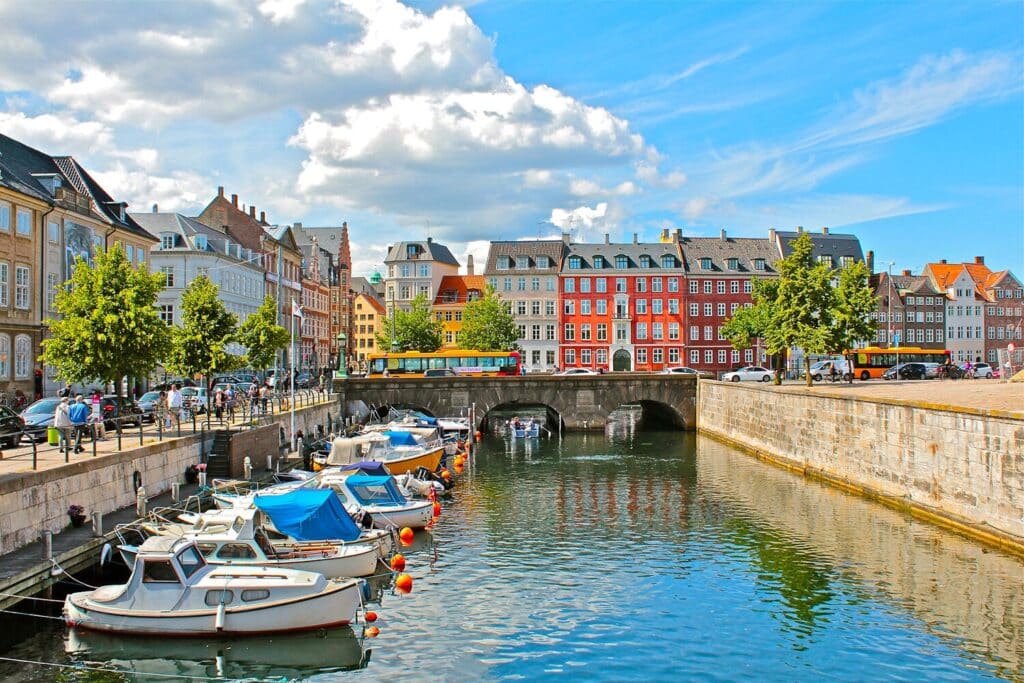
Copenhagen, Denmark
A Digital Nomad Guide to Copenhagen, Denmark
Copenhagen is Denmark’s capital city located on the islands of Zealand and Amager. It lies in the east of Denmark very close to the Swedish border which can be reached in under 30 minutes by car. Although Copenhagen is Denmark’s largest city it only has around 800,000 inhabitants which makes it very small compared to other global hubs. While Copenhagen’ population of digital nomads is not the largest it’s becoming more and more attractive for remote workers who appreciate the high quality of living and many things there are to do.
Copenhagen is a very open place with lots of opportunities for outdoor activities and exploring. This is an incredibly walkable city with everything you’ll want to see in one place. Since Denmark is such a small country this is where all the action is and you’ll never be more than a car or ferry ride away from new places.
Copenhagen and Denmark in general are not very warm places. Expect a considerable amount of rain with cold winters and mild summers. This creates a favourable work environment with comfortable temperatures perfect for those who do not enjoy constant heat. Denmark is a great place to experience Europe and its incredible culture and history.
Of course, perks like great health-care, clean streets and affordable education come with high prices which you should keep in mind before making the choice to move to Copenhagen as a digital nomad. Expect to spend a lot more money on things like groceries, alcohol, clothing or furniture than you would in most other countries. If you have sufficient funds though you will absolutely love Copenhagen and all it has to offer. It is one of the prettiest cities in northern Europe and a great place to live and work remotely. If you’ve always dreamed of making Scandinavia your home Copenhagen is a fantastic choice.
Living in Copenhagen Overview
| $19.88 | |
| $7.60 | |
| $5.91 | |
| $2.99 | |
| $1.30 | |
| $3.65 | |
| $180.20 | |
| $38.53 | |
| $41.93 | |
| $1,648.56 |
Currency: Euro (€)
[erw_exchange_rates_widget lg=”en” tz=”0″ fm=”EUR” to=”EUR,USD,GBP,AUD,JPY,RUB” st=”primary” cd=”” am=”1″][/erw_exchange_rates_widget]
ATMs
Max Withdrawal: €400
Use of Credit Cards: Widely Accepted
Average Temperature °C
Average Temperature °F
Average Rainfall
Average Rain Days
Daily Sunshine Hours
Digital Nomad Personal Experience in Copenhagen
Copenhagen might not be the first place that comes to mind when thinking of digital nomad hubs around the world. However, there is a reason why almost 10 million tourists visit this beautiful city every year.
As a digital nomad, I enjoy living in places where other people might go on their holiday. Not only is Copenhagen a beautiful city for sightseeing and exploring, it’s also attractive because of its versatile nature and high standards of living. This is definitely a place for those who enjoy cooler temperatures and like traditional seasons with cold winters and mild summers. I personally found that I got used to living in a colder climate faster than I expected. You still get to enjoy a lot of outdoor time, especially in the summer. In winter the city is so beautiful with Christmas markets and sometimes even snow that it is difficult not to feel cosy and at home.
If culture and city-living is your priority then you’ll absolutely love Copenhagen. Just be prepared to spend some money especially if you want to live in the city centre. Although I knew how expensive Denmark and Scandinavia in general were, I was still surprised by how much I was spending just on groceries, transport and rent every month. Copenhagen is definitely not a budget-friendly city and my most important piece of advice is to only come here as a digital nomad if you are completely financially stable. Luckily, you can make some money on the side if you are from a European country and do not need a work visa. Since the minimum wage is quite high this could help take off some financial pressure in the beginning. Copenhagen is definitely underrated as a digital nomad destination and should be at the top of your list for places to live and work remotely in Europe.
Work in Copenhagen
Copenhagen is a fantastic place for those who work remotely and do not have a set workspace or office. Since apartments tend to be quite small in the city you will most likely want to either join a coworking space or get your work done in one of the many coffee shops around town. If you’re on a budget and don’t want to commit to an expensive membership you should look into university libraries around the city. Some of these allow public access or you can get a membership for free. You’ll get a peaceful work environment and all the facilities you need.
Copenhagen is said to have one of the fastest average wifi speeds in the world which means you’re very likely to have a fast internet connection wherever you go. Most coworking spaces offer free trials so definitely try out a few before you decide which one is for you. Here are some of the best coworking spaces in Copenhagen.
Best Places to Work in Copenhagen
Symbion
With 4 different locations in Copenhagen, Symbion coworking space offers the best choice for digital nomads looking for flexibility and comfort. From a private office to a virtual workspace, there are various offers available at this modern coworking space. The hot desk membership costs $225 per month and gives you access to the all the most important amenities. You can enjoy access to printers, high speed internet, free coffee and tea and plenty of parking spaces if you’re coming by car. There is also a cafeteria so you don’t even have to leave the building to take your lunch break. Two of Symbion’s co-working locations in Copenhagen also have their own gym which you can use free of charge. This is a great way to save some money and get your exercise in after a long day of work.
Regus
Similar to Symbion, Regus coworking spaces are a large chain that offer many different locations spread around Copenhagen. If you’re frequently coming to large cities as a digital nomad you should look into purchasing a membership for this coworking space which can have many benefits such as world-wide access to airport lounges and office spaces. Depending on where you are staying in Copenhagen you should be able to find a Regus coworking space not too far from where you live. Prices for their memberships vary between $230 and $490 per month, depending on the location you choose. Each coworking space is equipped with modern facilities and high speed internet as well as the usual amenities.
Republikken
Situated only about 3 minutes from Copenhagen Central Station, Republikken coworking space is very centrally located. The relaxed environment offers the perfect place to get work done and be productive. Various workshops are offered on a regular basis, providing many opportunities for remote workers to gather new ideas and network. Republikken is often named as the best coworking space in Copenhagen and is especially popular amongst the digital nomad community. Once a month there is a free breakfast where you can explore new projects and connect with potential collaborators. Flex desk access costs around $305 per month and gives you 24/7 access to the usual amenities with your own access card.
Rainmaking Loft, Talent Garden
The Rainmaking Loft coworking space in Copenhagen is all about culture and making connections. Located in a historic building in the heart of Copenhagen this space is not just a workplace but an opportunity to truly immerse yourself in the city. With morning yoga, beer events and jazz nights this space puts a focus on networking and creating a community. Flex desk rates start at 220$ per month and there are memberships available that let you work across all locations world wide.
Best Places to Live in Copenhagen
Best Neighbourhoods
As is the case with many large cities the most expensive neighbourhoods tend to be near the city centre. As a digital nomad, you’ll want to be close to everything without having to spend a lot of time on public transport. Luckily, Copenhagen is not a very large city and even the outskirts are decently easy to reach. If you’re flexible with your budget you should definitely have a look at some city-centre apartments near Christianshavn which can have stunning views and are usually located in historic buildings. However, expect to pay upwards of 2,000$ per month for a very basic space.
As a remote worker on a budget, you might be a lot better off living in a suburb or a neighbourhood a bus-ride away from the city. This doesn’t necessarily have to mean you’ll be far away from all the places of interest. Even just a 10-minute car ride from the city can mean more affordable housing and far better deals.
Nørrebro
Copenhagen has a considerable expat community many of which live in Nørrebro, a neighbourhood very close to the city with excellent public transport links. Amager, which is the southern island on which much of Copenhagen is located has also become a popular choice for apartments, especially around Amagerbro.
Vesterbro
Vesterbro which was the former red-light district of Copenhagen is another new and upcoming neighbourhood which used to be very affordable but is slowly becoming more and more popular for those looking for a central location on a budget. Definitely look for apartments in this area but you’ll have to be quick to get a good deal. All of these areas have a good selection of little bars, cafes and stores which makes them lively and a good choice if you’re new to the city.
Østerbro
If you’re coming to Copenhagen with your family you should look into finding an apartment in the neighbourhood of Østerbro. This area is quite large and very popular amongst expat families. You’ll find plenty of outdoor spaces and opportunities for shopping and errands. Of course, prices here will not be cheap especially if you’re looking for 2 or 3 bedroom apartments. Definitely expect to pay a considerable amount of money if you choose to move here.
For a more budget-friendly option look for places on Nordvest which is a popular student neighbourhood. This is a great area for younger digital nomads wanting to connect with others their age. Housing tends to be reasonably affordable here but the demand is high so finding an apartment might take some time.
The Suburbs
Finally, there are Valby and Vanløse which can truly be considered suburbs. It can take around 40 minutes to get into the city by public transport from here but you’ll get to enjoy a more nature-based lifestyle with lots of parks and even lakes nearby. In addition to that you’ll be able to find much larger rental properties and even houses at reasonable prices. This is a great opportunity for those looking for some outdoor space and more than just a small city centre apartment.
Find an Apartment in Copenhagen
Finding an apartment in Copenhagen will not be easy. Affordable housing is hard to come by and apartments tend to go very quickly once they become vacant. You’ll rarely find a place that is posted more than one or two months in advance so beginning your search too early will not be helpful unless you’re prepared to pay rent without actually living in the city.
The majority of rentals in Copenhagen will be apartments although you can find some houses in the suburbs. If you have limited time in Copenhagen it’s definitely worth finding a place online before you arrive. You might end up paying some rent for time you are not actually living in Copenhagen but if you wait to find somewhere until you arrival it could take a few months to find a good spot.
Another thing to keep in mind is that landlords in Denmark tend to have a lot of requirements. You’ll usually be asked to pay a sizeable deposit as well as three months rent in advance. This can really add up so make sure you’re prepared to have these funds available before you move to Copenhagen.
If you’re on a budget and want to avoid paperwork you should consider renting a room in a shared house. These can be affordable and will make dealing with deposits, utilities and things like wifi or a TV licence a lot easier.
One of the best ways to find an apartment in Copenhagen can be through social connections. If you happen to know someone who’s lived in Denmark recently or who is from there then definitely ask them if they could keep an eye out for available places for you. Denmark is very small so even someone who is not living in Copenhagen will know someone who is. Rentals are never on the market for very long so make use of any advantage you can possibly find.
Facebook groups are very effective for finding housing in almost every country. Make sure to keep an eye out for new listings constantly and try to join a variety of different groups to find out which ones are effective.
Housing portals are also a good way of browsing for accommodation in Denmark although some of them can be tricky to navigate. The selection of portals is vast and their names are very similar. Most operate through a subscription service where you have to pay on a weekly or monthly basis to be able to contact landlords. This can quickly become very expensive so make sure you keep track of any open subscriptions. Some of the best portals include boligportal.dk , minlejebolig.dk , akutbolig.dk and housingcompany.dk.
Prices for accommodation in Copenhagen vary a lot according to location. You could find a room in a shared house with a central location for around 800$ per month or a studio apartment close to the city centre for approximately 1500$. A larger apartment with 1-2 bedrooms will easily cost upwards of 2000$ so keep that in mind if you’re coming to Copenhagen with a family.
Cheap Places to Stay in Copenhagen
It’s difficult to find affordable housing anywhere in Copenhagen but your best bet, if you’re on a budget, will be renting a room in a shared house. This is best done through Facebook groups or friends if you happen to already know someone in Copenhagen. Rooms tend to go quickly so make sure to follow up and book a viewing as soon as possible. If you’re lucky you might be able to find a very basic room a little bit outside the city centre for around 500$ per month. Brønshøj and Vanløse are two very affordable neighbourhoods where you’ll be able to find the best offers. Also, keep an eye out for student areas where you could be able to find cheap accommodation. Keep in mind though that universities in Copenhagen don’t even guarantee housing for their own students so it’s not going to be easy to find somewhere cheap.
Hostels will not necessarily be cheap in Copenhagen although you could ask around if some might be offering long term rentals. You could try the same with Airbnb apartments but again, housing is hard to come by in Copenhagen so landlords might be reluctant to offer discounted prices. Always inform yourself what exactly you have to pay before signing any contracts and read the terms and conditions carefully. If you’re only in Copenhagen for a few months it might be worth paying a bit more for a short term place to stay like an Airbnb to avoid having to deal with rental agreements, deposits and contracts.
Copenhagen Visa
Whether you will need a visa to live in Denmark as a digital nomad will depend a lot on your own nationality and the passport you carry. As someone from the EU you are free to move between Schengen countries and essentially live and work wherever you please. After 3 months in Denmark, you are required to apply for residency which is a decently straightforward process. If you are an active job seeker you don’t have to apply for this until 6 months after you arrive.
This means that living in Copenhagen will be a lot easier for anyone from countries in Europe since they are allowed to work there and a lot of things like health insurance and taxes are quite easy to transfer. If you are from somewhere outside of Europe you need to apply for a visa to enter Denmark. The Schengen visa lets you visit a large number of countries in Europe without having to apply for different permits. You can cross borders without having to show your passport or go through an immigration process. This will make moving between countries in Europe a lot easier and more convenient. Unfortunately, the Schengen visa is only valid for 90 days in a 180-day period. If you want to stay in Denmark longer it will be quite tricky to get a long term visa. These exist but have strict requirements such as business reasons or family. If you’re planning to make Denmark your permanent home this could be an option though so applying might be worth it.
Culture and Food in Copenhagen
A large part of the Danish culture is the so-called “Hygge”. This concept is not easily translated but means something along the lines of feeling good and comfortable when spending time with friends and family. It can be compared to feeling contempt and cosy and is a word you’ll come across frequently when living in Denmark.
The Danish people are said to be polite, reliable and trusting which is reflected in their culture and everyday life in Copenhagen. Like many European countries, Denmark has its own traditional costumes which date back to the 18th century. Costumes are worn for special occasions but are not as common anymore as they used to be. Each region in Denmark has slightly different designs for these traditional garments which differ in cut and colour.
Denmark has a number of unusual traditions and customs that you won’t find anywhere else in the world except for maybe Sweden or Norway. On New Year’s eve, it’s a common tradition to “jump into the new year”. For this everyone will climb on top of a chair or table and jump together when the clock strikes midnight. During midsummer celebrations, bonfires on the beach are a popular activity to celebrate summer. In some cases, a doll is placed on top of the bonfire to symbolise the burning of a witch. While you most likely won’t find this in the city centre of Copenhagen it’s a fun tradition you should keep an eye out for if you’re seeing the countryside during this time.
When Danish students graduate from highschool they celebrate by riding around town in big open-air trucks. They stop at each student’s house to be greeted by friends and family with drinks and food. This tradition is especially popular in smaller towns and can be a lot of fun if you’re involved.
Copenhagen is known for its incredible cuisine and Michelin star restaurants. If fancy dining is not something you can afford you should definitely visit Reffen Food hall, a hip and modern location for some of Denmark’s best street food. With an area of more than 6000 m^2 and 50 chefs there is an incredible selection available for all tastes. The food is world-class and chefs are constantly trying to outdo each other with creative new dishes from all around the world. This is an absolute must-do when living in Copenhagen and shouldn’t be missed.
Denmark is known for its Smørrebrød, open sandwiches served with all sorts of cold cuts, cheeses and other toppings. Seafood is very important in the Danish cuisine and you should absolutely try the pickled herrings at least once. For lunch a kolde bord or cold buffet is often served which usually contains all sorts of Smørrebrød, finger foods and snacks. While it’s hard to assign a single national dish to Denmark fried pork with potatoes and parsley sauce probably comes closest. This dish has been perfected for hundreds of years and should be tried at least once when living in Copenhagen.
Copenhagen Nightlife
Copenhagen is a fantastic city to get a taste of European nightlife. Whether you want to go clubbing, have cocktails in a bar or are just looking for a casual place to have some drinks with friends, there is something for everyone in this city.
Vesterbro is definitely the most popular area for nightlife in Copenhagen. It’s popular amongst the younger generation and a great spot for lively bars and parties that last all night long. You’ll find some clubs here too but a large majority are located in the city centre. You’ll find plenty of opportunities to party the night away here with cocktail bars and live music. Some of the most popular clubs include Chateau Motel, Culture Box, Sigurd, and Hive.
Nørrebro is another great choice for bars and late night dining. Come here to have a drink with friends in hip bars or to get some work done in a nice cafe during the day. If you’re living in this neighbourhood you will never find yourself bored because there’s always something to do.
A fun way to experience Copenhagen’s nightlife is to go on a pub crawl. For around 22$ you’ll be taken to different bars around the city including some free drinks and entrance to a club. Joining a pub crawl is a great way to make friends if you’re new to Copenhagen and want to have fun on a night out even if you don’t know very many people yet. Pub crawls are available Tuesdays, Thursdays, Fridays and Saturdays.
Clubs in Copenhagen are open very late and the best nightlife usually doesn’t start until after midnight. Those who are on a budget like students like to have drinks at someone’s apartment before they go out which helps save money. If you enjoy dancing all night Copenhagen is definitely the city for you. Most clubs don’t close until 5:00 or 6:00 am and even then you’ll be able to find after parties and places that are still open. Definitely have a late night snack at one of the small restaurants that are still open during this time for the best experience.
Denmark has a very strong drinking culture and a passion for beer brewing. Copenhagen actually has one of the highest ratios of bars per inhabitant so there is always one around. Especially in summer you can sit outside and enjoy the nice weather with a cold drink. In winter you should try the mulled wine that is available at the Christmas markets around town.
If clubbing is not your thing why not head to one of Copenhagen’s quieter bars like the 1656, The Barking Dog, Ruby or Gensyn Bar. These are not necessarily upscale but have a more traditional atmosphere and are great spots to spend an evening with friends.
Alcohol and nightlife don’t come cheap in Copenhagen. Expect to spend at least 4$ to 10$ for a beer in a bar in the city centre and between 12$ and 15$ for a cocktail.
Things to do in Copenhagen
Copenhagen is a city rich in culture and history. You can spend your days visiting museums, walking through the old town and enjoying life on the water. If you’re interested in seeing all the best parts of Copenhagen in a budget-conscious way you should consider buying the Copenhagen Card during your stay. This city pass includes admission to 87 different attractions in Copenhagen and even a public transport ticket. This is a great choice if you’re planning on seeing a lot of attractions in a short amount of time. Cards are available for 1, 2, 3, 4 and 5 days and cost between 70 and 160$. This can definitely be worth it if you want to visit some of the attractions on this list.
Here are some of the best things to do in Copenhagen.
Enjoy the canal in Nyhavn
Nyhavn, which translates to new harbour, is a historic harbour area situated along a canal dating back to the 17th century. On both sides of the canal you can walk along the promenade with old houses from the 1600s and 1700s. On the ground floors you’ll find a great selection of small bars, restaurants or cafes, some of which also offer outdoor seating. This area is very popular for having a coffee or a beer in the summer and watching the hustle and bustle on the canal.
Visit the Nationalmuseet
If you’re looking for an activity for a rainy day, the National Museum of Copenhagen is a great place to visit. There are many artefacts from all periods of Danish history on display as well as a great section on the history of the Vikings. This is an interesting and educational place to learn a bit more about Denmark’s past. Entrance costs 9$ but the museum is included in the Copenhagen card.
Take a tour through Christiansborg Palace
Christiansborg Palace was once home to kings and queens and other royals. Today it houses the Danish Parliament, the Supreme Court and the Ministry of State. The large halls of the building are still used by the royal family for state receptions and other events. For the equivalent of $27, you can get a combination ticket that allows you to visit many parts of the building with a free guided tour. If you don’t want to visit the entire building, it is best to check the website to see which areas you are interested in and book them accordingly. Visiting the Christiansborg Palace is an absolute must-do for anyone seeing Copenhagen for the first time.
Stroll through the Botanical Garden
The botanical garden of Copenhagen was established as early as the 16th century. On the approximately 10-hectare site you will still find old greenhouses that can be traced back to 1870. Visiting the botanical garden is free of charge but keep in mind that access with dogs is not permitted if you’re travelling with a furry friend. In the middle of the park, you will find the Palm House, which you can visit for $10. Here you will find countless rare and exotic plants from various tropical and subtropical environments. There is also a butterfly house where you can observe and learn about the life of butterflies in summer. This is the perfect activity for kids of all ages so make sure to plan a family trip here.
Explore the Rosenborg Castle
Another stunning palace to visit in Copenhagen is the Rosenborg Castle. It was built in the early years of the 16th century and was expanded continuously. The interior of this palace has changed little over time and features historical tapestries and paintings depicting the conflicts between Denmark and Sweden. The entrance fee of around $20 is not cheap but definitely worth it for those interested in the story of the country and its royal history.
Visit Christiania
Christiania is located on an old military site in Christianshavn. It is often described as a “state-tolerated autonomous community” because it was occupied and settled by the citizens of Coppenhagen in 1971 due to the housing shortage. Today it can be seen as a peaceful park with old historical army camps and barracks where a commune lives peacefully and independently from the rest of the city. In the old buildings you can now find many small cafes, restaurants or the odd artist’s studio. Go for an afternoon walk here and experience life in a completely different way.
Watch the change of guards at the Amalienborg Palace
Amalienborg Palace is the residence of Queen Margrethe II and the royal family in Copenhagen. Every day around noon you can watch the changing of the guards which is always a worthwhile spectacle. The members of the royal guard march daily from their barracks in the city to the palace to stand guard. The guards are recognisable by their blue uniforms and traditional bearskin helmets. If the queen is at home, they are also accompanied by a marching band. Watching the changing of the guards is a fun way to experience Danish culture with the entire family.
Take a tour at the Carlsberg brewery
If you travel abroad a lot, you’ve probably come across Carlsberg beer all around the world. The brewery is the fourth largest in the world and has its origins in Copenhagen. Visiting the old brewery buildings has become one of the most popular tourist attractions in Copenhagen. A tour is a good way to learn more about Carlsberg’s roots, history and, of course, the beer. You won’t be surprised that the last stop of the guided tours is a bar where you can taste the free beers included in the ticket price of 16$. Various non-alcoholic drinks are, of course, also available.
Climb the historic round tower from the 17th century.
The round tower of Copenhagen is the oldest observatory still in operation in the whole of Europe. A very narrow spiral staircase takes you to the observation deck at a height of 36 metres. From there you have an indescribable 360° view over the whole of Copenhagen. The climb costs $6.50 if you don’t have the Copenhagen Card, otherwise it’s free.
Best Time to Visit Copenhagen
Denmark’s climate offers cold winters and mild summers. As the country is small and flat, there is not much difference in temperatures between the different areas so the weather will be quite similar wherever you go. In the west of the Jutland Peninsula, however, it is somewhat milder, windier and rainier than in the rest of Denmark.
On average, you can expect around 102 rainy days throughout the year in Copenhagen. From November to March, the cold winter prevails with temperatures around the freezing point that do not vary much between day and night. The days are very short due to the northern location and the sun sets as early as 3:00 pm in the afternoon. During this time, rain or even snowfall is common, but usually does not last long.
From the end of March to mid-June is the time of spring. It remains quite cool but there is relatively little rain. The maximum temperatures in Copenhagen during these months are between 11°C and 16°C. Summer highs from late June to mid-September are around 22°C during the day and 13°C at night. You won’t have extremely hot summers in Copenhagen but the weather is usually pleasant and comfortable for outdoor activities.
Autumn from late September to the beginning of November is often rainy and sometimes very windy. If you enjoy swimming in the sea, the best time to do so is in the months of July and August when the water temperature is at its highest with an average of 18°C. If you decide to go to Copenhagen in the summer, bring clothes that you can easily layer as temperatures can change quite quickly. In winter, don’t forget a hat, scarf, gloves and a warm and dense winter jacket. An umbrella is always advisable to carry throughout the year.
Copenhagen for Families
Copenhagen is a safe and clean city perfect for digital nomads who are travelling with their families. Denmark has a great health care system and social safety net so life there can be quite comfortable. Child care and education is either free or very affordable in Denmark which is a huge benefit.
However, keep in mind that public schooling will, of course, be in Danish which can be a tricky language to learn. If you have small children they will catch on quickly but for older ones you might want to consider sending them to one of the international schools in Copenhagen. There are three in the city; Copenhagen International School, Rygaards International School and the European School Copenhagen. They all charge tuition fees since they are considered private schools which you need to keep in mind. Prices vary greatly but can go up to several thousands per year.
Although education is free you shouldn’t underestimate how much life with kids is going to cost you in Denmark. An apartment with 2 bedrooms can easily cost 2000$ per month and if you need more space your budget might not be large enough. Definitely consider this before you move to Copenhagen with your family, there are a lot more affordable places in Denmark or Europe.
Luckily there is always something to do with the whole family in Copenhagen. You’ll find a great selection of playgrounds around the city or museums that cater for all ages. Definitely put the Experimentarium on your must-see list. This incredible science centre is interactive and perfect for children of all ages. You’ll also love the Copenhagen Zoo or Tivoli Gardens, a fun amusement park located in the heart of the city. On the weekends you can take the whole family on day-trips around Denmark or even Sweden to experience the incredible culture and enjoy nature.
Living in Copenhagen
Copenhagen Transportation
Copenhagen is known for being a very walkable city with a great public transport system. As someone living in Copenhagen for an extended period of time, you’ll appreciate how reliable and convenient both the trains and buses are for getting around. If you’re living somewhere close to the city centre you might not even feel a need to use transport at all since everything is easy to reach on foot. However, due to the sometimes unpleasant weather, taking the metro will become a lifesaver on rainy days.
Copenhagen’s metro system is one of the best in the world and will take you to most of the important places around town. Trains run between every 2 and 15 minutes including at night depending on the time. This means that even if you’re out late you’ll always be able to get home without having to hire a taxi. Buses and trains can be used interchangeably with the same ticket so switching is easy and convenient. You can buy tickets at metro stations or with bus drivers directly.
Buses in Copenhagen tend to be a bit slower than the metro or other trains. If you’re short on time this might not be the best choice but there are far more bus routes than for the metro which will let you get to suburbs or places outside the city.
Public transport operates in zones in Copenhagen which means there are different price categories depending on which zones you’re crossing. It’s highly advisable to get a monthly ticket which will be more affordable if you use public transport a lot. These exist according to zones or in a version where all zones are covered in a flat-rate fee.
Taxis
Copenhagen is a great city to get around via a taxi service because it is not overcrowded, so taxis are reliable. It is a requirement in Denmark to have a taxi driver’s license in order to drive a taxi and the driver must drive for a licensed and registered company, which makes Denmark one of the most secure places to ride a taxi.
This is also why companies like Uber and Lyft are not allowed to operate in Denmark.
One important thing to note is that it is always possible to pay either with cash or card. Also there are no special prices for tourists.
There are many taxi companies in Denmark, but the largest and oldest company is taxa.dk. It’s also possible to rent a sightseeing taxi, and get around Copenhagen on your own time while getting a guided tour around the historical city of Copenhagen.
Copenhagen also has the so-called harbour bus which is an electric ferry that takes you from Sluseholmen to Refshaleøen along the harbour. The ferry is included in public transport tickets for this zone and is very affordable even if you buy a separate ticket. It’s a nice way to see the city from the water for tourists and locals alike.
On days with good weather, a popular way to get around the city is by bike. Copenhagen is a very bike-friendly city and you should consider buying one if you’re going to be living there for a while. There are also public e-bikes for rent all around the city which you can pick up and only pay for the time you are actually using them. This is a budget and eco-friendly way to commute and very convenient.
There is no real need to buy a car when you live in Copenhagen since you can walk most of the time or take a metro. Parking is expensive and hard to come by in the city so having a car will most likely not be a huge benefit. If you’re planning on doing lots of day-trips and seeing more of Denmark and the Scandinavian countries it could be convenient to own one but for daily life you’ll easily get by without. Unless you’re living very far out of the city you’ll always be able to find a good public transport link.
Fitness and Health
Copenhagen is a versatile city with many opportunities for staying fit and healthy. You’ll most likely be doing a considerable amount of walking and biking if you’re living in Copenhagen which will help you stay fit in daily life. Of course, you’ll find a great selection of gyms around the city many of which belong to larger chains which means you might be able to use different gyms interchangeably. Check out PureGym for a modern gym with a large selection of equipment. Their prices start at 50$ per month for the basic membership. They have multiple gyms around town so you’ll most likely find one near you. Sats Copenhagen is another great option if you enjoy working out in a gym. Their membership is slightly cheaper at only 44$ per month and they have discounts frequently.
Copenhagen is the capital city of Denmark so you’ll be able to find most sports here. If you don’t enjoy working out in a gym you should consider joining a local sports team like football or handball. There are also facilities such as dance studios, indoor swimming pools or even ice skating rinks. Copenhagen has something for everyone so staying fit in this city will not be a problem.
Since the city is very open and green you should get into running which can be especially pleasant in the spring or summer. Run along the river or the ocean and get to know the area while you are working out.
Copenhagen People
Around 800,000 people live in Copenhagen, 73% of which are of Danish descent with the rest representing the immigrant population. While Denmark is not known for being a very multicultural country you’ll find people from all over the world in Copenhagen. Due to its small size, many expats feel like Copenhagen is not as overwhelming as other much larger capital cities worldwide with more opportunities to network and join a community.
The Danish people have been repeatedly ranked in the top three of the happiest nations in the world. This is often attributed to the high standards of living, social equality and advanced social safety system in this country. Although you’ll notice how expensive many things in daily life are in Denmark this translates directly to the favourable living conditions and openness of this beautiful country.
The people in Copenhagen are friendly and welcoming towards foreigners. Copenhagen is a great place for members of the LGBTQ+ community and there are very few occurrences of discrimination in every day life.
Depending on where you are originally from living in Denmark might be very different from what you are used to as a digital nomad. Some expats have noted the reserved and private nature of the Danish people which can make it difficult to find friends initially. Similar to the other European countries like Germany, the Netherlands or Sweden the people in Denmark tend to be very polite and to the point unlike cultures in the Americas, southern Europe or other places around the world. As a digital nomad, it might take some time to adjust to the Danish lifestyle and truly immerse yourself in the culture of Copenhagen.
To find friends and make local connections it’s always advisable to turn to Facebook groups dedicated to expats in the city. You might not meet a lot of Danish people this way but you’ll get a chance to get your bearings and be introduced to Copenhagen by other foreigners who might have struggled in the beginning as well. You should also consider moving into a shared house which will not only be more budget friendly than a private apartment but also encourage you to meet new people and make connections.
It is estimated that around 86% of Danes speak some level of English which means you’ll always be able to communicate. Of course, Danish is the national language and most things in Copenhagen take place in Danish but the people are used to foreigners who only speak English so if you’re only in the city for a short time there is no real need to learn the language. Danish is said to be the hardest Scandinavian language to learn and can be tricky for native English speakers because of its pronunciation and speaking patterns. Definitely learn some of the basics to help you in everyday life or take a language class if you’re planning on spending more time in Denmark.
Copenhagen Insurance and Medical Care
Denmark has an excellent health care system and most medical care is actually free for residents. As a foreigner, you’ll, unfortunately, have to pay for any treatments you receive while in Denmark. A basic doctor’s appointment can quickly cost you up to 100$ if you do not have insurance.
If you’re planning on living in Denmark permanently you could consider looking into different Danish health insurance covers which will save you from having to pay every time you visit the doctor. As a digital nomad who might only be in Copenhagen for a few months, this is not advisable and you should look into obtaining health insurance from your own home country. There are usually options for expats and travellers that insure you world-wide even if you travel spontaneously. This cover might not come cheap but it will be worth it, in the long run, should you need medical treatments abroad.
If you are living and working in Denmark permanently you might be eligible for free health insurance. Discuss this with your employer to find out details or contact an insurance company for an individual quote.
If you do need to go to a doctor in Copenhagen you’ll be pleased to know that the process is usually quite straightforward and simple. The vast majority of doctors speak fluent English, especially in a large city. Appointments are easy to make and there are usually no long waiting times. Always keep any receipts from payments to give to your insurance company later on so they can reimburse you.
Make sure you are fully covered by reading our full Digital Nomad Travel Insurance guide.
Jobs in Copenhagen
Unless you are an EU national you need to have a valid work permit to be able to find a job in Denmark. This will not be easy unless you are going to be working for a Danish company. As a non-EU citizen who wants to live in Copenhagen temporarily, you’ll be a lot better off finding work online and making money remotely than trying to acquire a work permit.
If you are thinking of making Denmark your permanent home, however, there could be many benefits to finding a local job. Wages are very high in this part of the world due to the high living costs. You could be earning a decent amount of money even for unskilled jobs.
If you are an EU citizen you’ll have good chances of finding work either in your field or in a casual environment like a bar or restaurant. Of course, the job market is competitive in a capital city like Copenhagen but there are usually a good amount of opportunities for work around. Keep in mind that depending on the type of job you’ll most likely be required to speak some level of Danish. While a lot of Copenhagen operates in English you’ll need to be able to communicate with people so don’t come to the city assuming you’ll find a job without at least basic knowledge of the language. Of course, this depends a lot on the field you’re working in but for most casual jobs this will be the case. If you’re looking for work with large companies in a professional setting English will most likely be sufficient.
Check out our Digital Nomads Jobs Postings to find the best jobs available for Digital Nomads.
Cost of Living Copenhagen
It’s no secret that Copenhagen and Denmark in general are very expensive. Calculate your budget per month and then add at least another 300$ to make it more realistic. Rent will be your largest expense and you need to factor in the deposit that many landlords require which can mean you might have to pay several thousands up front.
If you’re coming to Copenhagen on a very tight budget you might be able to find a room in a shared house for around 600-700$ per month which could make your monthly expenses slightly more manageable. You also need to consider how expensive things like eating out or alcohol are in Copenhagen. If you’re planning on having drinks with friends or enjoying the nightlife you need to factor in at least a few hundred dollars in your monthly budget.
Luckily at least the transport in Copenhagen is reasonable. You’ll be able to walk and bike to most places so there is no need to buy a car unless you’re living far out in the suburbs with your family. For around 100$ you’ll get a monthly public transport ticket which will let you use buses, metros and even the ferry interchangeably.
Sample expenses for one month in Copenhagen
Essential costs
- Basic one-bedroom apartment – $1200
- Bills for water, gas, electricity, wifi – $250
- Public transport – $100
- Groceries – $200
- Cell phone plan – $20
≈ $1770 total per month
Optional costs
- Eating out and nightlife – $400
- Membership at a coworking space – $220
- Health insurance (varies greatly according to country) – $35 – $100
- Gym membership – $50
- Gasoline – $150
- City bike – $100




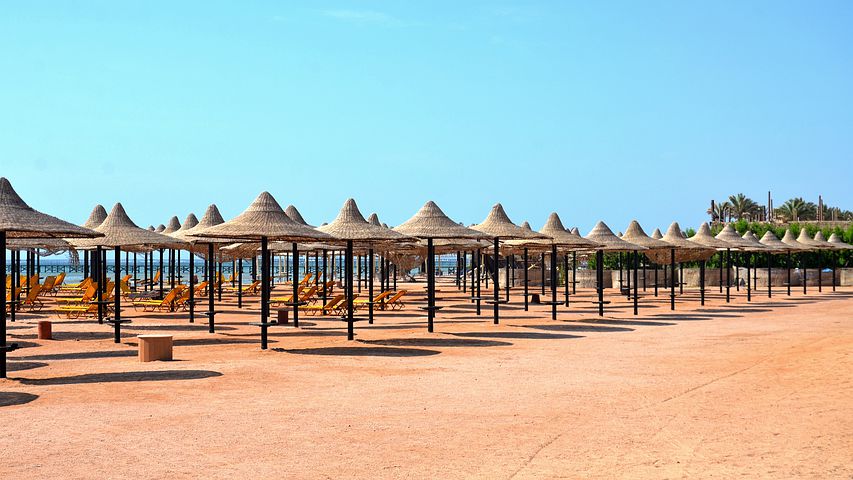
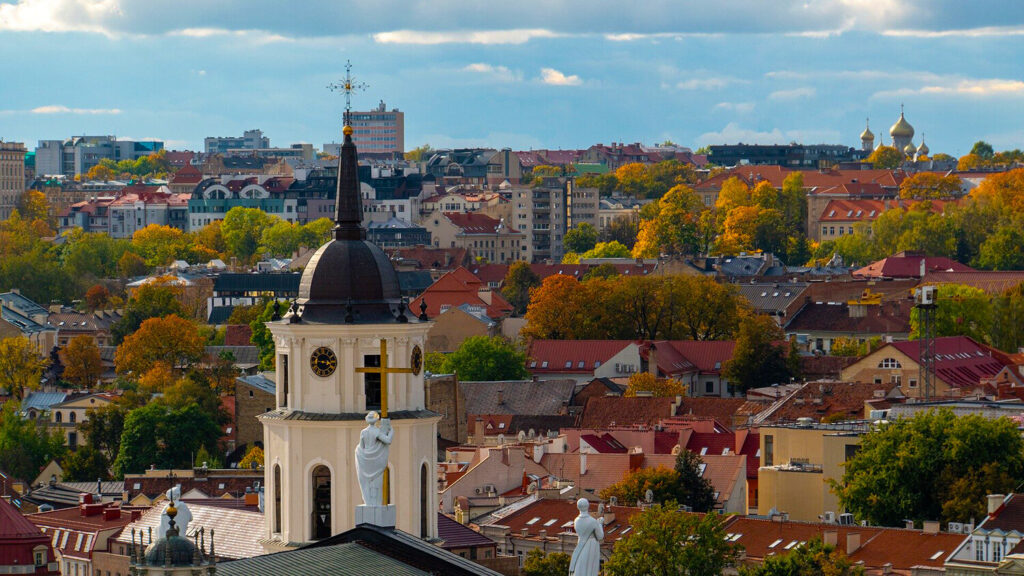

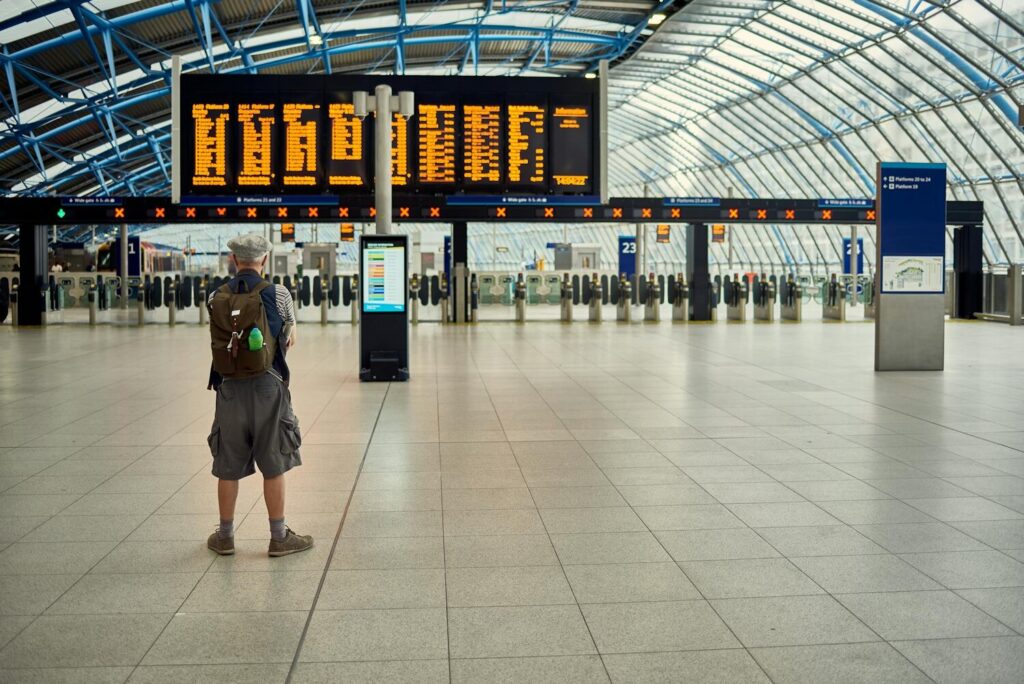
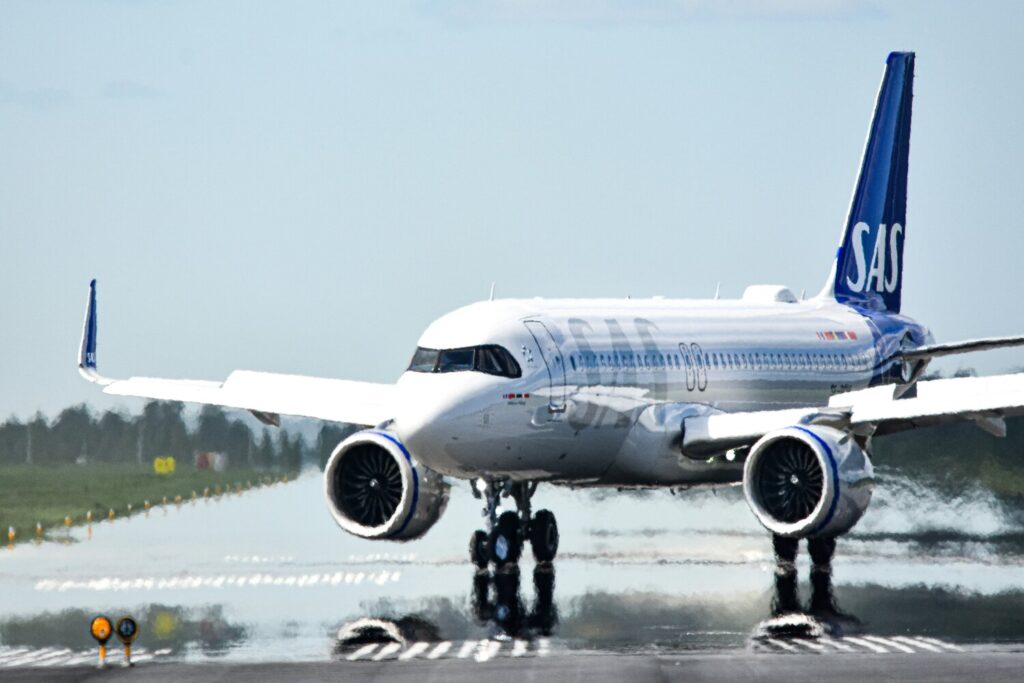
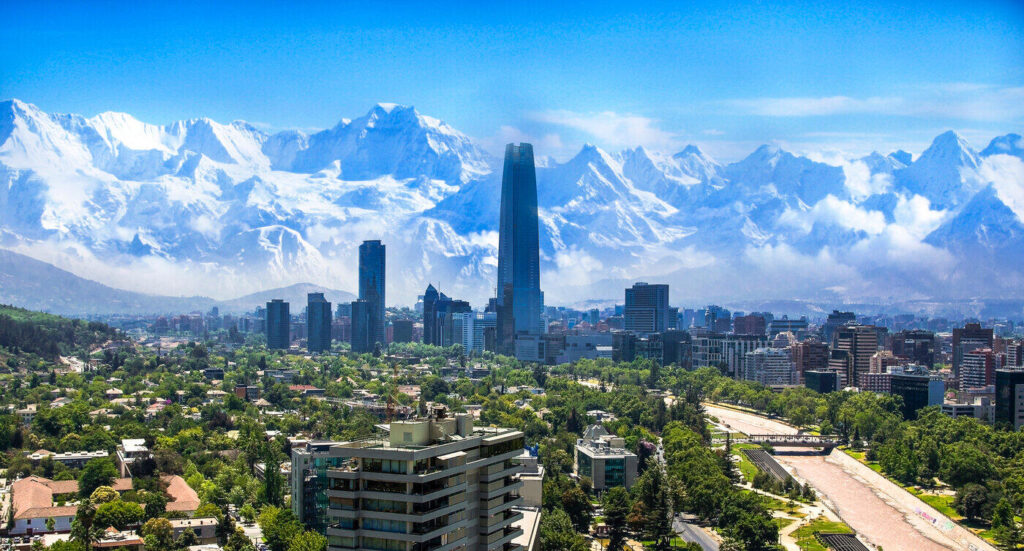


Responses